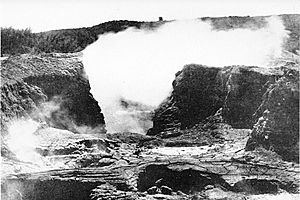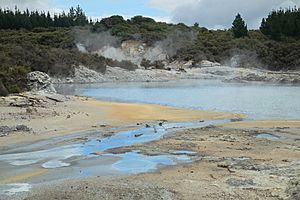Tikitere facts for kids
Quick facts for kids
Tikitere
|
|
|---|---|
|
Rural locality
|
|

Hot pools in 2019
|
|
| Country | New Zealand |
| Region | Bay of Plenty |
| Territorial authority | Rotorua Lakes District |
| Ward | Te Ipu Wai Auraki General Ward |
| Community | Partly in Rotorua Lakes Community |
| Electorates |
|
| Area | |
| • Total | 4.24 km2 (1.64 sq mi) |
| Population
(June 2023)
|
|
| • Total | 770 |
| • Density | 181.6/km2 (470/sq mi) |
| Postcode(s) |
3074
|
Tikitere, also known as "Hell's Gate", is a cool suburb in Rotorua, New Zealand. It's famous for being in one of New Zealand's most active geothermal areas. You can find it on State Highway 30, between Lake Rotorua and Lake Rotoiti in the Bay of Plenty.
This amazing place has lots of geothermal features. You'll see steaming lakes, bubbling mudpools, steam vents, and even a mud volcano. It's also home to the Kakahi Falls, which is the biggest hot waterfall in the southern hemisphere!
The "Hell's Gate" area is a popular spot for visitors. You can take tours to explore the geothermal park and learn about its history. It's also a great place to discover more about Māori culture. Plus, they have a special mud spa where you can relax!
Contents
Discovering Tikitere's Past
The geothermal area of Tikitere was created about 10,000 years ago. This happened during a series of geothermal eruptions. These eruptions drained an old lake and helped form Lake Rotoiti and Lake Rotorua. When the water pressure on the rocks was removed, it created cracks. Steam and gases can now escape through these cracks.
Māori History and Legends
The local Māori tribe, Ngāti Rangiteaorere, has lived in this area for over 700 years. They still own this amazing geothermal attraction today. The Māori name Tikitere comes from a sad story. A Māori princess named Hurutini, who was married to a mean chief, threw herself into a boiling hot pool. This pool is still named after her.
When Hurutini's mother found her daughter, she cried out, "Aue teri nei tiki!" This means "here lies my precious one." This cry was shortened to Tikitere, and that's how the thermal reserve got its name.
How "Hell's Gate" Got Its Name
The name "Hell's Gate" became popular after a famous Irish writer, George Bernard Shaw, visited in 1934. He thought the area looked like what his friends in England described "hell" to be. He felt it was like a gateway to another world!
The local Māori owners were very happy with his visit. To honor him, they decided to use "Hell's Gate" as the English name for the geothermal area. People have been using the hot, sulfurous waters here for spas since as early as 1871.
Waiōhewa Marae
The Tikitere area is also home to Waiōhewa Marae. This is a special meeting place for the Ngāti Rangiteaorere tribe. It includes the Rangiwhakaekeau meeting house.
Tikitere's Population
Tikitere is a rural settlement. In 2018, about 702 people lived there. The population has grown over the years, showing more people are choosing to live in this unique area.
Most people living in Tikitere are of European or Māori descent. Many people in the area also have no religious affiliation, while others are Christian or follow Māori religious beliefs.
Exploring Tikitere's Attractions
The geothermal park is about 50 acres in size. You can explore it by taking two easy walking paths. These paths are mostly flat and take about 45 to 60 minutes to walk.
Lower Geothermal Area
The lower part of the park has a loop walk with bridges and viewing platforms. Here, you'll find about a dozen hot pools. Some of these pools have interesting names like "Sodom and Gomorrah" and "Devil's Bath." They are quite deep, about 15 to 25 meters.
The water in pools like "Inferno Pools" and "Sodom and Gomorrah" can get super hot, over 100 degrees Celsius! This is because of the minerals in the water. Sometimes, "Sodom and Gomorrah" can even erupt, sending water up to 2 meters high! Most other pools are around 60 to 70 degrees Celsius. The Huritini hot spring provides water for the sulfur spas at Hell's Gate.
The water in these pools is usually quite acidic. Some pools, like the "Ink Pots," are very acidic with a pH level of 2. The "Sulphur Bath" can even reach a pH of 1. George Bernard Shaw also gave names to several other geothermal features in this area.
Kakahi Falls: The Hot Waterfall
Between the lower and upper areas, there's a short, easy walk along a stream. This stream flows over the Kakahi Falls. This waterfall is 4 meters tall and is the largest hot waterfall in the southern hemisphere! The water here is about 40 degrees Celsius.
Kakahi Falls has always been a special place for the local Māori people. Warriors would use it to clean themselves after battles. The sulfur in the water helped to disinfect their wounds. The full name of the waterfall is "O Te Mimi O Te Kakahi," named after a famous chief and warrior. The stream itself is the overflow from the upper geothermal area.
Upper Geothermal Area
A longer loop walk takes you through the upper geothermal area. Here, you'll see large hot pools with different levels of activity. You'll also find steaming steam vents. You might even spot sulfur crystals in some places.
This area also has several mud cauldrons with boiling black mud. There's a large mud volcano, which is currently about 2 meters tall. The mud usually bubbles violently in the volcano's crater. About every six weeks, the mud volcano hardens. Then, after 2-3 days of pressure building up, a mud eruption happens, splattering mud up to 2 meters around the volcano!
The Steaming Cliffs pool is the hottest pool in this area, reaching 122 degrees Celsius at the surface! Other pools in the upper area range from 40 to 90 degrees Celsius. In the past, these pools were used for cooking and for medicine, like treating skin problems and arthritis. The grey mud and water from one of these pools are used in Hell's Gate's mud spa.
Mud Spa and Maze Fun
Right next to the entrance of Hell's Gate, you'll find the mud spa. They offer mud footpools and several mud baths. You can also get different mud treatments and massages. If you like the mud, you can buy mud-based beauty products at the on-site shop. Hell's Gate also has educational programs for schools.
For over 40 years, Rotorua's 3D Maze has been a famous attraction in Tikitere. After some challenges in 2021, the maze reopened in December 2022 as Wonderworld 3D Maze Rotorua.
Learning in Tikitere
Te Kura Kaupapa Māori o Ruamata is a special school in Tikitere. It's a co-educational state Kura Kaupapa Māori for students from Year 1 to 13. This means it's a school where students learn in the Māori language and follow Māori cultural practices.
Science of Tikitere
Geology: How the Land Was Formed
The Tikitere-Ruahine geothermal field is part of the Rotorua Volcanic Centre. It covers about 10 square kilometers. This area has acid springs, pools, small lakes, steam vents, and mudpools. It also has hot, barren ground where the rocks have changed due to the heat. The heat coming from underground here is very strong.
The special features you see are formed when acid water interacts with volcanic rock. This leaves behind a silica residue. This is different from other geothermal areas where silica forms from hot, neutral water. Tikitere is located in an area called the Tikitere Graben, where the land is slowly sinking.
Biology: Life in Hot Water
The acid waters in Tikitere are home to special types of extremophile bacteria. These are tiny living things that can survive in extreme conditions, like very hot and acidic water! Scientists have studied some of these unique bacteria found in Tikitere.





